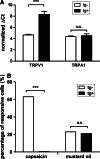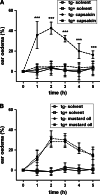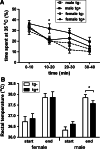Nociception, neurogenic inflammation and thermoregulation in TRPV1 knockdown transgenic mice
- PMID: 21069423
- PMCID: PMC11115187
- DOI: 10.1007/s00018-010-0569-2
Nociception, neurogenic inflammation and thermoregulation in TRPV1 knockdown transgenic mice
Abstract
Transgenic mice with a small hairpin RNA construct interfering with the expression of transient receptor potential vanilloid 1 (TRPV1) were created by lentiviral transgenesis. TRPV1 expression level in transgenic mice was reduced to 8% while the expression of ankyrin repeat domain 1 (TRPA1) was unchanged. Ear oedema induced by topical application of TRPV1 agonist capsaicin was completely absent in TRPV1 knockdown mice. Thermoregulatory behaviour in relation to environmental thermopreference (30 vs. 35°C) was slightly impaired in male knockdown mice, but the reduction of TRPV1 function was not associated with enhanced hyperthermia. TRPV1 agonist resiniferatoxin induced hypothermia and tail vasodilatation was markedly inhibited in knockdown mice. In conclusion, shRNA-mediated knock down of the TRPV1 receptor in mice induced robust inhibition of the responses to TRPV1 agonists without altering the expression, gating function or neurogenic oedema provoked by TRPA1 activation. Thermoregulatory behaviour in response to heat was inhibited, but enhanced hyperthermia was not observed.
Figures






Similar articles
-
The vanilloid receptor TRPV1 is tonically activated in vivo and involved in body temperature regulation.J Neurosci. 2007 Mar 28;27(13):3366-74. doi: 10.1523/JNEUROSCI.4833-06.2007. J Neurosci. 2007. PMID: 17392452 Free PMC article.
-
7-tert-Butyl-6-(4-chloro-phenyl)-2-thioxo-2,3-dihydro-1H-pyrido[2,3-d]pyrimidin-4-one, a classic polymodal inhibitor of transient receptor potential vanilloid type 1 with a reduced liability for hyperthermia, is analgesic and ameliorates visceral hypersensitivity.J Pharmacol Exp Ther. 2012 Aug;342(2):389-98. doi: 10.1124/jpet.112.191932. Epub 2012 May 7. J Pharmacol Exp Ther. 2012. PMID: 22566669
-
Antihyperalgesic effects of (R,E)-N-(2-hydroxy-2,3-dihydro-1H-inden-4-yl)-3-(2-(piperidin-1-yl)-4-(trifluoromethyl)phenyl)-acrylamide (AMG8562), a novel transient receptor potential vanilloid type 1 modulator that does not cause hyperthermia in rats.J Pharmacol Exp Ther. 2008 Jul;326(1):218-29. doi: 10.1124/jpet.107.132233. Epub 2008 Apr 17. J Pharmacol Exp Ther. 2008. PMID: 18420600
-
Body-temperature maintenance as the predominant function of the vanilloid receptor TRPV1.Trends Pharmacol Sci. 2008 Nov;29(11):550-7. doi: 10.1016/j.tips.2008.08.003. Epub 2008 Sep 19. Trends Pharmacol Sci. 2008. PMID: 18805596 Review.
-
Effect of capsaicin on thermoregulation: an update with new aspects.Temperature (Austin). 2015 Jun 2;2(2):277-96. doi: 10.1080/23328940.2015.1048928. eCollection 2015 Apr-Jun. Temperature (Austin). 2015. PMID: 27227029 Free PMC article. Review.
Cited by
-
Defective channels lead to an impaired skin barrier.J Cell Sci. 2014 Oct 15;127(Pt 20):4343-50. doi: 10.1242/jcs.154633. Epub 2014 Sep 1. J Cell Sci. 2014. PMID: 25179597 Free PMC article. Review.
-
Functionally important amino acid residues in the transient receptor potential vanilloid 1 (TRPV1) ion channel--an overview of the current mutational data.Mol Pain. 2013 Jun 22;9:30. doi: 10.1186/1744-8069-9-30. Mol Pain. 2013. PMID: 23800232 Free PMC article. Review.
-
Transient receptor potential channels in the vasculature.Physiol Rev. 2015 Apr;95(2):645-90. doi: 10.1152/physrev.00026.2014. Physiol Rev. 2015. PMID: 25834234 Free PMC article. Review.
-
Polysulfide evokes acute pain through the activation of nociceptive TRPA1 in mouse sensory neurons.Mol Pain. 2015 May 2;11:24. doi: 10.1186/s12990-015-0023-4. Mol Pain. 2015. PMID: 25934637 Free PMC article.
-
The functions of TRPA1 and TRPV1: moving away from sensory nerves.Br J Pharmacol. 2012 May;166(2):510-21. doi: 10.1111/j.1476-5381.2012.01851.x. Br J Pharmacol. 2012. PMID: 22233379 Free PMC article. Review.
References
-
- Szolcsányi J. Capsaicin receptors as target molecules on nociceptors for development of novel analgesic agents. In: Kéri Gy, Toth J., editors. Molecular pathomechanisms and new trends in drug research. London: Taylor and Francis; 2002.
Publication types
MeSH terms
Substances
LinkOut - more resources
Full Text Sources
Other Literature Sources
Medical

